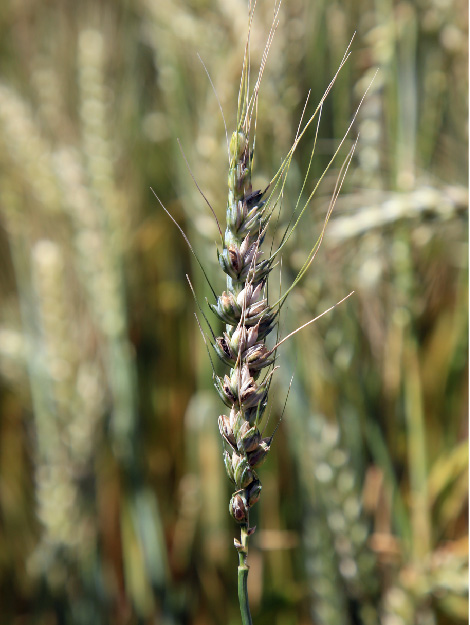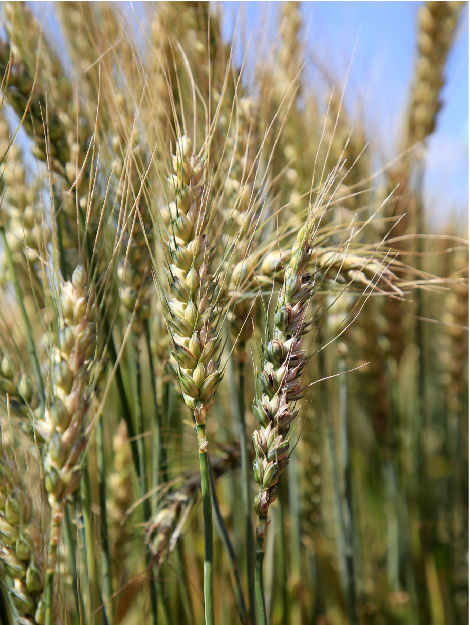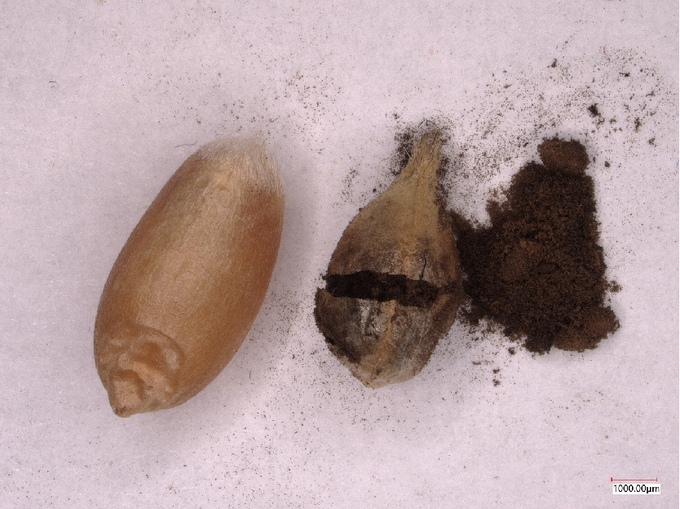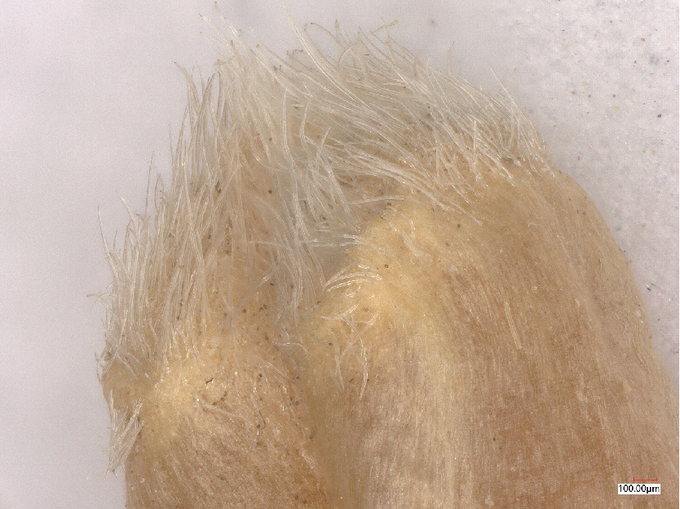Common bunt of wheat
Tilletia caries
Profile
Common stone blight or wheat stone blight is a seed-borne fungus with a high multiplication potential that reduces grain quality. It is also called stink blight because it can cause an intense fishy odor to the crop. In case of severe infestation with common stone blight, high yield losses and only limited usability of the crop (also for feed purposes) are to be expected.
Biology
The blight spores are located on the outside of the grain, on the seed coat. After cultivation, in good conditions (moist and cool), the blight spores germinate with the grain. The germinated spore grows along with the plant in the growing shoot and causes the formation of blight instead of healthy grain kernels during ear formation. During threshing of the gangrenous ears, the gangrenous butts are broken up and the spore mass is distributed on the seed coat of the freshly harvested grains. Thus, the cycle is closed and the spores are ready for the next sowing on the new seed.
Damage symptoms
Infestation with wheat stem blight remains unnoticed until ear emergence, when infected plants become visible. Host plants infected with common wheat blight can be identified by the appearance of blue-green discoloration on the spikelets and the spreading of the glumes.
When infected with common stone blight, blight butts are formed instead of seeds, which spread the typical strong fishy odor and are filled with a large number of spores. This leads to spreading of the glumes. Infected plants may appear somewhat blue-green, but the coloration also depends on the wheat variety. Delayed maturity and fringed-appearing ears may be another indication of infestation. In individual ears, the black spore mass may already be visible in the field as maturity increases.
The spore mass of the blight is protected only by a thin membrane, which is broken during harvest. As a result, the spores get onto the healthy grains and get stuck mainly in the hairs and the fold.
Symptoms during threshing:
- Formation of a black cloud (in case of heavy contamination).
- Strong foul smell (fishy smell, due to trimethylamine).
If such symptoms are noticed during threshing, it is advised to stop harvesting that field, even if no symptoms were previously detected in the field. Even a small amount of burnt grains in the field (0.1%) is enough to create a rotten fish smell for the entire crop, which is not systematically noticeable at first, but only develops at a higher level of contamination, making the entire lot unusable for consumption and as animal feed.




Propagation and transmission
Seeds are considered the primary source of infection. However, rock blight spores can also survive in the soil for years, making it a source of infection as well.
Temperatures between 2 °C and 29 °C (optimum at 11 °C) and soil moisture between 40 and 50 % favor the development of rock blight.
Economic importance
The risks of a rock blight infection are very high yield losses, up to 70% of the grain ears can be infected. This results in unsaleable crops and contamination of the soil.
Toxic effects from consumption of infested grain are not known. Consumer goods and feed must nevertheless not show any infestation.
Prevention and control
- A varied crop rotation is the basis for preventing seed diseases. For common wheat blight, a crop rotation of three to five years is generally recommended.
- Since seed is considered the main vector of wheat stem blight infections, it is essential that only healthy seed is used.
- For farm-saved seed we recommend:
- Monitor your fields closely during ear emergence to detect infection early.
- If you plan to use farm-saved seed, have your seed tested at anaccredited laboratory to detect wheat stone blight.
- Apply a seed treatment if necessary (depending on lab results).
- Cool, damp weather at the time of germination is conducive to infection with common stone blight. To reduce the risk of infection, sowing should be selected to promote rapid plant development.
- Tillage: Rock blight spores require oxygen and water to germinate. Deep tillage of the spores into the soil should be avoided as this will conserve the spores. The next time the soil is tilled, they are brought back to the surface and can infect the plants again. If the spores are left on the surface, most will germinate within two to four months after harvest if there is sufficient soil moisture. In addition, springtails living in the first few inches below the soil can eat and destroy the spores (Borgen, 2001). Thus, to promote the best possible decomposition of the spores, it is beneficial to perform only shallow tillage (e.g., tilling) after harvest.
- Regular inspection of field stands allows early detection and the opportunity to remove infected plants.
- Harvesting equipment used must be thoroughly cleaned (e.g., with hot soapy water) before use on other fields to prevent contamination of subsequent crops. Fields with heavy infestations should be threshed last, as spores can adhere to harvesting equipment and contaminate subsequent crops. At lower levels of infestation, harvesting crops that cannot be infected with common rock blight (e.g., soybeans, corn, etc.) may be sufficient as a cleanup measure.
- By destroying heavily infected crops, you prevent a source of inoculation on your own farm.
- If there is heavy infection with rock blight in a field plot, the soil must also be considered infected. The survivability of spores in the soil is highly dependent on soil texture. A five-year growing interval should be sufficient before growing susceptible crop species in the particular field.
Specialized information
Other rock blight species
In Austria, there is also the dwarf rock blight(Tilletia controversa). In addition to the symptoms mentioned for common rock blight, this also causes plant dwarfing. It usually occurs in harsher areas with long winters (e.g. Upper Austria, Waldviertel, etc.). This pathogen is soil-borne, but is introduced into stands via seed and can persist in the soil for up to 10 years.
Indian wheat blight(T. indica) occurs mainly in India and its neighboring countries, North America, and South America. It is regulated as a quarantine pest in Europe.
Susceptibility of crop species
When comparing the susceptibility of different crop types, common wheat, spelt, and einkorn are among the most susceptible crop types to stone blight infection.
In triticale, susceptibility is highly variegated. Rye has a lower, but not negligible, potential for infection, and barley and oats are considered to be resistant to stone blight.
To date, there is no wheat variety that is completely resistant to wheat stem blight. However, it is known that some varieties are more susceptible than others. In Austria, there are currently three varieties that are largely resistant to common wheat blight: Tillexus (4% blight), Tilliko, and Tillstop (1% blight).
Wheat stone blight detection tests
Visual detection of wheat stone blight, either in a plot (inspection of ears) or in a seed lot (presence of blight spores), is very difficult and random, especially when the contamination rate is quite low. Analysis by an accredited laboratory is the surest way to detect stone blight of wheat. For certification of seed, testing for stone blight is mandatory in Austria. We perform the testing of seeds for wheat stem blight for seed companies, farmers and growers.
The official test for the detection of stone blight is a filtration test. In this test, a defined quantity of grains is washed with warm water and the suspension is then transferred to a filter paper by means of a pump. The number of spores present is detected under the microscope and the type of rock fire is determined. However, this method cannot differentiate between viable and non-viable spores. Fresh spore material, however, usually has a very high vitality. In Austria there is currently no possibility to test the viability of spores.
The "bucket test" is a simple, approximate test for blight in harvested grain. Place 5 kg of grain in a container filled with water, stir, and collect floating grains on the surface. Stir until no more grains float up on the surface. Then examine the collected floated grains grain by grain and determine whether they are fire butts or not (fire butts are lighter than seeds and therefore float up, these are filled with a black spore mass). This technique provides only a rough detection for the presence of fire butts. Spores adhering to the grain cannot be detected by this method. In the case of seeds (whether farm-saved or certified), this test should in no case be considered and used as a substitute for laboratory analysis.
Last updated: 10.04.2025
automatically translated